Deck 19: Cell Junctions and the Extracellular Matrix
Question
Question
Question
Question
Question
Question
Question
Question
Question
Question
Question
Question
Question
Question
Question
Question
Question
Question
Question
Question
Question
Question
Question
Question
Question
Question
Question
Question
Question
Question
Question
Question
Question
Question
Question
Question
Question
Question
Question
Question
Question
Question
Question
Question
Question
Question
Question
Question
Question
Question
Question
Question
Question
Question
Question
Question

Unlock Deck
Sign up to unlock the cards in this deck!
Unlock Deck
Unlock Deck
1/56
Play
Full screen (f)
Deck 19: Cell Junctions and the Extracellular Matrix
1
In the following schematic diagram of a simple columnar epithelium lining the digestive tract, indicate which position (A to F) along the basal-apical axis better corresponds to each of the following features. Your answer would be a six-letter string composed of letters A to F only, e.g. FEDABC.
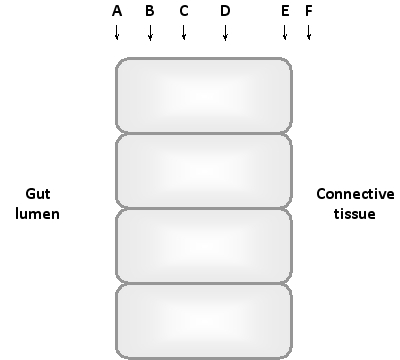
( ) Basal lamina
( ) Cell apex
( ) Adherens junctions
( ) Gap junctions
( ) Hemidesmosomes
( ) Tight junctions

( ) Basal lamina
( ) Cell apex
( ) Adherens junctions
( ) Gap junctions
( ) Hemidesmosomes
( ) Tight junctions
F
A
C
D
E
B
A
C
D
E
B
2
Selectins …
A) mainly mediate cell-matrix attachments.
B) are members of the Ig superfamily of cell adhesion molecules.
C) do NOT require Ca²⁺ for their adhesive function, unlike integrins.
D) are carbohydrate-binding proteins.
E) All of the above.
A) mainly mediate cell-matrix attachments.
B) are members of the Ig superfamily of cell adhesion molecules.
C) do NOT require Ca²⁺ for their adhesive function, unlike integrins.
D) are carbohydrate-binding proteins.
E) All of the above.
D
Explanation: Selectins are lectins that mediate transient, calcium-dependent cell-cell adhesions.
Explanation: Selectins are lectins that mediate transient, calcium-dependent cell-cell adhesions.
3
Cadherin molecules at the cell surface are often clustered side-to-side to create a molecular Velcro that attaches the cell to another cell or to the extracellular matrix. In the following simplified drawings, two cells are initially attached via such a Velcro. When one of the cells moves in either of three different ways (A to C), it is faced with a mechanical resistance from the cadherin interactions. The resistance against which type of movement do you think is the weakest? Write down A, B, or C as your answer. 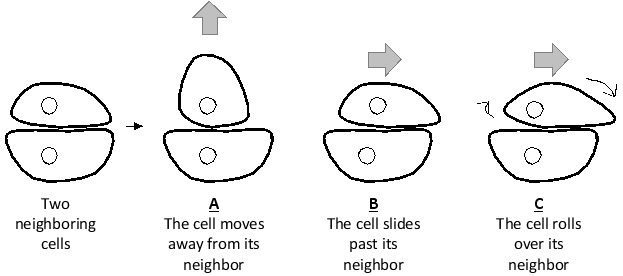

C
4
Consider a sheet of epithelial tissue that invaginates to form a tube along the anterior-posterior axis of a developing vertebrate embryo. The tube is then closed concomitant with a "convergence and extension" process similar to that observed in germ-band extension in Drosophila melanogaster. During this process, the tube elongates and narrows before pinching off from the sheet. Which axis (1 or 2) in the following schematic drawing of the tube cells do you think corresponds to the anterior-posterior axis? Write down 1 or 2 as your answer.
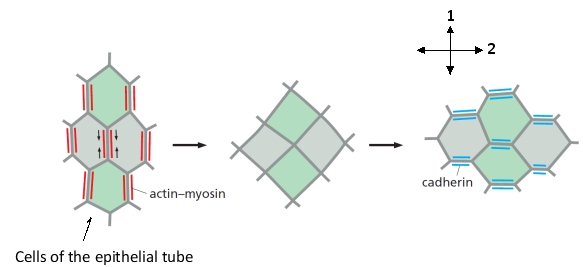


Unlock Deck
Unlock for access to all 56 flashcards in this deck.
Unlock Deck
k this deck
5
Plasmodesmata in plant cells are functionally similar to animal cells' …
A) adherens junctions.
B) desmosomes.
C) gap junctions.
D) hemidesmosomes.
E) tight junctions.
A) adherens junctions.
B) desmosomes.
C) gap junctions.
D) hemidesmosomes.
E) tight junctions.

Unlock Deck
Unlock for access to all 56 flashcards in this deck.
Unlock Deck
k this deck
6
Indicate true (T) and false (F) statements below regarding cadherins. Your answer would be a four-letter string composed of letters T and F only, e.g. TFTT.
( ) Cadherins are present in all multicellular organisms.
( ) Adhesion by cadherins is dependent on Ca²? ions.
( ) In contrast to nonclassical cadherins, classical cadherins are more closely related in sequence.
( ) E, N, and P cadherins are mainly found in desmosomes.
( ) Cadherins are present in all multicellular organisms.
( ) Adhesion by cadherins is dependent on Ca²? ions.
( ) In contrast to nonclassical cadherins, classical cadherins are more closely related in sequence.
( ) E, N, and P cadherins are mainly found in desmosomes.

Unlock Deck
Unlock for access to all 56 flashcards in this deck.
Unlock Deck
k this deck
7
In the following schematic diagram, the estimated attractive or repulsive force between two adhesive cells is plotted as a function of distance between the cells. The dashed curve represents a condition under which the cells express cadherin but not N-CAM. The other two curves represent conditions under which both cadherin and heavily sialylated N-CAM are expressed. In one of the conditions, however, the ionic strength of the medium has been artificially increased by addition of salt. Which curve (1 or 2) do you think represents the high-salt condition? Write down 1 or 2 as your answer.
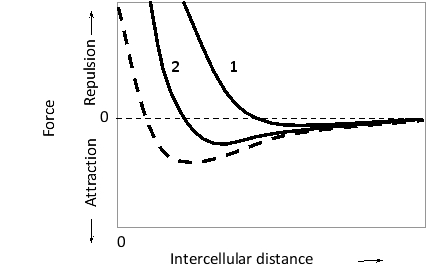


Unlock Deck
Unlock for access to all 56 flashcards in this deck.
Unlock Deck
k this deck
8
Indicate whether each of the following descriptions better applies to adherens junctions (A), desmosomes (D), gap junctions (G), or tight junctions (T). Your answer would be a four-letter string composed of letters A, D, G, and T only, e.g. AAAD.
( ) They play a direct role in structural polarization of epithelial cells.
( ) They couple cells both electrically and metabolically.
( ) They are formed from hexameric hemichannels that can assemble into heterotypic complexes.
( ) They create semipermeable paracellular pores.
( ) They play a direct role in structural polarization of epithelial cells.
( ) They couple cells both electrically and metabolically.
( ) They are formed from hexameric hemichannels that can assemble into heterotypic complexes.
( ) They create semipermeable paracellular pores.

Unlock Deck
Unlock for access to all 56 flashcards in this deck.
Unlock Deck
k this deck
9
Consider two cells attached to each other via adherens junctions. The forces generated by the actin cytoskeleton in one cell …
A) are dependent on myosin activity.
B) are normally balanced by similar forces in the neighboring cell.
C) can strengthen the adherens junction by unfolding catenin proteins.
D) All of the above.
A) are dependent on myosin activity.
B) are normally balanced by similar forces in the neighboring cell.
C) can strengthen the adherens junction by unfolding catenin proteins.
D) All of the above.

Unlock Deck
Unlock for access to all 56 flashcards in this deck.
Unlock Deck
k this deck
10
Overproduction of cadherins such as E-cadherin …
A) is often found in cancers originating from epithelia.
B) is induced by the transcription regulatory protein Twist.
C) induces epithelial-mesenchymal transition.
D) leads to stronger cell-cell adhesion.
E) All of the above.
A) is often found in cancers originating from epithelia.
B) is induced by the transcription regulatory protein Twist.
C) induces epithelial-mesenchymal transition.
D) leads to stronger cell-cell adhesion.
E) All of the above.

Unlock Deck
Unlock for access to all 56 flashcards in this deck.
Unlock Deck
k this deck
11
Fill in the blank in the following paragraph. Do not use abbreviations.
"Particularly abundant in cells of heart muscle and the epidermis, … are structurally similar to adherens junctions and contain a number of homologous components. However, their cadherin molecules are linked to intermediate filaments instead of the actin cytoskeleton."
"Particularly abundant in cells of heart muscle and the epidermis, … are structurally similar to adherens junctions and contain a number of homologous components. However, their cadherin molecules are linked to intermediate filaments instead of the actin cytoskeleton."

Unlock Deck
Unlock for access to all 56 flashcards in this deck.
Unlock Deck
k this deck
12
Cells expressing either N-cadherin (A), high levels of E-cadherin (B), or low levels of E-cadherin (C) have sorted themselves out on a substratum in a cadherin-dependent manner as shown in the schematic drawing below. Which cells (A to C) would you expect to correspond to white, gray, and black in the drawing, respectively? Your answer would be a three-letter string composed of letters A to C only, e.g. CAB.
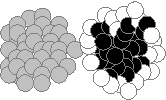


Unlock Deck
Unlock for access to all 56 flashcards in this deck.
Unlock Deck
k this deck
13
In the following schematic drawing of connexons as seen from the cytosol of a cell, what is the approximate diameter of each of the pores? Which of the indicated connexons (1 or 2) is more likely to have been incorporated more recently? 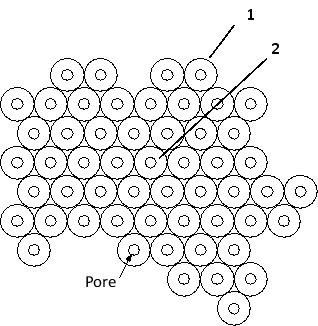
A) About 20 nm; connexon 1
B) About 4 nm; connexon 1
C) About 1.5 nm; connexon 1
D) About 4 nm; connexon 2
E) About 1.5 nm; connexon 2

A) About 20 nm; connexon 1
B) About 4 nm; connexon 1
C) About 1.5 nm; connexon 1
D) About 4 nm; connexon 2
E) About 1.5 nm; connexon 2

Unlock Deck
Unlock for access to all 56 flashcards in this deck.
Unlock Deck
k this deck
14
Which of the following is NOT an anchoring junction?
A) Adherens junction
B) Desmosome
C) Actin-linked cell-matrix junction
D) Hemidesmosome
E) Tight junction
A) Adherens junction
B) Desmosome
C) Actin-linked cell-matrix junction
D) Hemidesmosome
E) Tight junction

Unlock Deck
Unlock for access to all 56 flashcards in this deck.
Unlock Deck
k this deck
15
Which of the following cell junctions uses cadherin cell adhesion molecules to anchor the actin cytoskeleton?
A) Tight junction
B) Adherens junction
C) Desmosome
D) Hemidesmosome
E) Gap junction
A) Tight junction
B) Adherens junction
C) Desmosome
D) Hemidesmosome
E) Gap junction

Unlock Deck
Unlock for access to all 56 flashcards in this deck.
Unlock Deck
k this deck
16
Malignant cancer cells that have entered the bloodstream can imitate lymphocytes in exiting the bloodstream and entering underlying tissues in the process of metastasis. This "lymphocyte mimicry" can be summarized as …
A) an initial cadherin-dependent rolling followed by an integrin-dependent adhesion and emigration.
B) an initial cadherin-dependent rolling followed by an I-CAM-dependent adhesion and emigration.
C) an initial cadherin-dependent rolling followed by a selectin-dependent adhesion and emigration.
D) an initial selectin-dependent rolling followed by a cadherin-dependent adhesion and emigration.
E) an initial selectin-dependent rolling followed by an I-CAM-dependent adhesion and emigration.
A) an initial cadherin-dependent rolling followed by an integrin-dependent adhesion and emigration.
B) an initial cadherin-dependent rolling followed by an I-CAM-dependent adhesion and emigration.
C) an initial cadherin-dependent rolling followed by a selectin-dependent adhesion and emigration.
D) an initial selectin-dependent rolling followed by a cadherin-dependent adhesion and emigration.
E) an initial selectin-dependent rolling followed by an I-CAM-dependent adhesion and emigration.

Unlock Deck
Unlock for access to all 56 flashcards in this deck.
Unlock Deck
k this deck
17
Indicate whether each of the following descriptions better applies to connective (C) or epithelial (E) tissues. Your answer would be a four-letter string composed of letters C and E only, e.g. EEEE.
( ) Cells are usually distributed sparsely in the extracellular matrix.
( ) Gap junctions are rarely found.
( ) Direct cell-cell attachments are common.
( ) Cells are tightly associated into sheets.
( ) Cells are usually distributed sparsely in the extracellular matrix.
( ) Gap junctions are rarely found.
( ) Direct cell-cell attachments are common.
( ) Cells are tightly associated into sheets.

Unlock Deck
Unlock for access to all 56 flashcards in this deck.
Unlock Deck
k this deck
18
A researcher has grown monolayers of cells from either of two epithelial cell lines on a permeable supporting membrane that separates two electrolyte chambers. One of the cell lines (A) has been derived from the mammalian kidney and forms epithelial sheets resembling those lining the renal collecting duct and the urinary bladder. The other (B) is derived from the mammalian small intestine. The researcher has measured the voltage (V) and electrical current (I) across the monolayer and has plotted the results in the graph below. Which line (1 or 2) in the graph do you think corresponds to cell line A? Recall that current (I) is related to the applied voltage (V) by the equation I = V/R, in which R is the electrical resistance. Write down 1 or 2 as your answer.
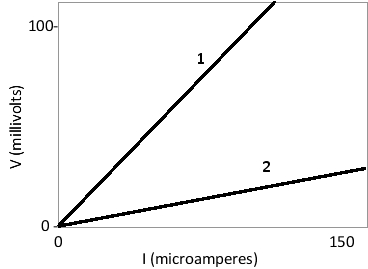


Unlock Deck
Unlock for access to all 56 flashcards in this deck.
Unlock Deck
k this deck
19
In insects such as Drosophila melanogaster, electrical synapses are abundant in the ventral nerve cord. Unlike a chemical synapse, the cytosols of pre- and postsynaptic cells in an electrical synapse are connected, allowing action potentials to spread rapidly and without delay. What junctional proteins in the flies are chiefly responsible for this unique feature of the electrical synapses?
A) Cadherins
B) Claudins
C) Connexins
D) Innexins
E) Integrins
A) Cadherins
B) Claudins
C) Connexins
D) Innexins
E) Integrins

Unlock Deck
Unlock for access to all 56 flashcards in this deck.
Unlock Deck
k this deck
20
You have isolated epithelial cells from mouse mammary glands and have grown them in a three-dimensional gelatinous matrix in the presence or absence of a specific inhibitor that targets a transmembrane metalloprotease. The protease is capable of cleaving cadherin near the base of its extracellular domain to release an N-terminal fragment containing the extracellular cadherin domains. The distribution of the cells in the matrix, as seen under a light microscope, one day after the transplantation of the isolated tissue is presented in the following schematic drawings. Which condition (1 or 2) do you think corresponds to the presence of the protease inhibitor? Write down 1 or 2 as your answer.
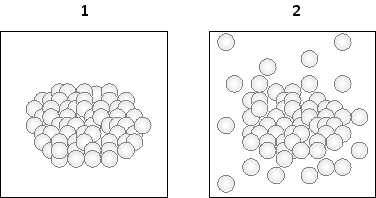


Unlock Deck
Unlock for access to all 56 flashcards in this deck.
Unlock Deck
k this deck
21
Which collagens are the most common in our body?
A) Fibrillar
B) Fibril-associated
C) Network-forming
D) Proteoglycan core
E) Anchorage fibril
A) Fibrillar
B) Fibril-associated
C) Network-forming
D) Proteoglycan core
E) Anchorage fibril

Unlock Deck
Unlock for access to all 56 flashcards in this deck.
Unlock Deck
k this deck
22
This large glycoprotein of the extracellular matrix is associated with elastin fibers and is essential for their integrity. Its deposition in the developing connective tissues often precedes the appearance of elastin. It is part of microfibrils that cover the elastic fibers. This protein is …
A) collagen.
B) fibronectin.
C) fibrillin.
D) filamin.
E) laminin.
A) collagen.
B) fibronectin.
C) fibrillin.
D) filamin.
E) laminin.

Unlock Deck
Unlock for access to all 56 flashcards in this deck.
Unlock Deck
k this deck
23
Which of the following is true regarding fibril-associated collagens such as type IX collagen?
A) They aggregate with one another to form long fibrils in the extracellular space.
B) They lack the triple-stranded helical structure found in other collagens.
C) They are more flexible than collagens of types I to IV.
D) They are the most common among collagens.
E) All of the above.
A) They aggregate with one another to form long fibrils in the extracellular space.
B) They lack the triple-stranded helical structure found in other collagens.
C) They are more flexible than collagens of types I to IV.
D) They are the most common among collagens.
E) All of the above.

Unlock Deck
Unlock for access to all 56 flashcards in this deck.
Unlock Deck
k this deck
24
The elasticity of the components of the extracellular matrix can be visualized in a stress-strain curve, in which the tensile stress (corresponding to load) applied to a tissue sample is plotted against the strain (corresponding to deformation) measured in the tissue. In the following stress-strain graph, the elasticity of an intact connective tissue is represented by a dashed curve. The other two curves correspond to the same tissue that has been treated with either formic acid (to digest collagen) or trypsin (to digest elastin). Which curve (1 or 2) do you think corresponds to trypsin treatment?
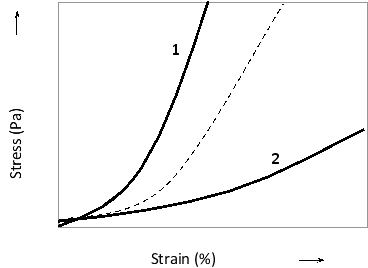


Unlock Deck
Unlock for access to all 56 flashcards in this deck.
Unlock Deck
k this deck
25
Indicate true (T) and false (F) statements below regarding fibronectin in the extracellular matrix. Your answer would be a four-letter string composed of letters T and F only, e.g. TFTT.
( ) Fibronectin carries asparagine-linked oligosaccharides.
( ) Fibronectin often forms homodimers by cross-linking through covalent attachment of lysine residues.
( ) Fibronectin binds to integrins, collagens, and glycosaminoglycans through its type III repeats.
( ) Fibronectin molecules can assemble into fibrils only in the vicinity of cells.
( ) Fibronectin carries asparagine-linked oligosaccharides.
( ) Fibronectin often forms homodimers by cross-linking through covalent attachment of lysine residues.
( ) Fibronectin binds to integrins, collagens, and glycosaminoglycans through its type III repeats.
( ) Fibronectin molecules can assemble into fibrils only in the vicinity of cells.

Unlock Deck
Unlock for access to all 56 flashcards in this deck.
Unlock Deck
k this deck
26
Neuromuscular junctions of vertebrates are special types of chemical synapses formed from close association between motor neuron axon terminals and muscle fibers. A thin layer of basal lamina separates the two cell membranes at the neuromuscular junction and is important for its organization and maintenance. Which of the following would you NOT expect to find in the basal lamina in these structures?
A) Nidogen
B) Laminin
C) Type I collagen
D) Type IV collagen
E) Perlecan
A) Nidogen
B) Laminin
C) Type I collagen
D) Type IV collagen
E) Perlecan

Unlock Deck
Unlock for access to all 56 flashcards in this deck.
Unlock Deck
k this deck
27
Indicate true (T) and false (F) statements below regarding the interaction of cells with the extracellular matrix using matrix receptors. Your answer would be a four-letter string composed of letters T and F only, e.g. TFTT.
( ) Integrins are the only known matrix receptors in animal cells.
( ) Integrins can transmit signals in both directions across the membrane; that is, both outside-in and inside-out.
( ) Tension can increase the binding affinity of an integrin for its intracellular and extracellular ligands.
( ) Integrins can convert molecular signals into mechanical ones.
( ) Integrins are the only known matrix receptors in animal cells.
( ) Integrins can transmit signals in both directions across the membrane; that is, both outside-in and inside-out.
( ) Tension can increase the binding affinity of an integrin for its intracellular and extracellular ligands.
( ) Integrins can convert molecular signals into mechanical ones.

Unlock Deck
Unlock for access to all 56 flashcards in this deck.
Unlock Deck
k this deck
28
Fill in the blank in the following paragraph regarding the extracellular matrix. Do not use abbreviations.
"The extracellular matrix of connective tissues in animals is primarily made and secreted by the … family of cells, although they may have more specific names in certain tissues. Being common in connective tissues, these cells can also migrate and proliferate if need be."
"The extracellular matrix of connective tissues in animals is primarily made and secreted by the … family of cells, although they may have more specific names in certain tissues. Being common in connective tissues, these cells can also migrate and proliferate if need be."

Unlock Deck
Unlock for access to all 56 flashcards in this deck.
Unlock Deck
k this deck
29
Indicate true (T) and false (F) statements below regarding glycosaminoglycan chains in the extracellular matrix. Your answer would be a four-letter string composed of letters T and F only, e.g. TFTT.
( ) They are highly branched polysaccharides.
( ) They are strongly hydrophilic and absorb a large amount of water.
( ) They all contain N-acetylglucosamine or N-acetylgalactosamine.
( ) They are highly positively charged.
( ) They are highly branched polysaccharides.
( ) They are strongly hydrophilic and absorb a large amount of water.
( ) They all contain N-acetylglucosamine or N-acetylgalactosamine.
( ) They are highly positively charged.

Unlock Deck
Unlock for access to all 56 flashcards in this deck.
Unlock Deck
k this deck
30
A giant aggrecan aggregate can have a molecular mass of 10⁸ daltons or more, and can be as large as a bacterium. Its structure resembles a brush. What is responsible for attaching the bristles of the brush to its core?
A) Covalent bonds between aggrecan core protein and keratan or chondroitin sulfate.
B) Noncovalent bonds between aggrecan core protein and keratan or chondroitin sulfate.
C) Covalent bonds between aggrecan core protein and hyaluronan.
D) Noncovalent bonds between aggrecan core protein and hyaluronan.
A) Covalent bonds between aggrecan core protein and keratan or chondroitin sulfate.
B) Noncovalent bonds between aggrecan core protein and keratan or chondroitin sulfate.
C) Covalent bonds between aggrecan core protein and hyaluronan.
D) Noncovalent bonds between aggrecan core protein and hyaluronan.

Unlock Deck
Unlock for access to all 56 flashcards in this deck.
Unlock Deck
k this deck
31
Indicate whether each of the following descriptions better applies to the intracellular (I) or extracellular (E) domain of integrins. Your answer would be a four-letter string composed of letters I and E only, e.g. EEEE.
( ) It binds to talin.
( ) It binds to the RGD tripeptide motif.
( ) It is bulkier.
( ) It contains divalent cation-binding domains.
( ) It binds to talin.
( ) It binds to the RGD tripeptide motif.
( ) It is bulkier.
( ) It contains divalent cation-binding domains.

Unlock Deck
Unlock for access to all 56 flashcards in this deck.
Unlock Deck
k this deck
32
Which of the following extracellular matrix components contains a transmembrane protein?
A) Type I collagen
B) Perlecan
C) Aggrecan
D) Syndecan
E) Decorin
A) Type I collagen
B) Perlecan
C) Aggrecan
D) Syndecan
E) Decorin

Unlock Deck
Unlock for access to all 56 flashcards in this deck.
Unlock Deck
k this deck
33
Collagens are extremely rich in …
A) alanine and valine.
B) glycine and proline.
C) lysine and arginine.
D) serine and threonine.
E) tyrosine and phenylalanine.
A) alanine and valine.
B) glycine and proline.
C) lysine and arginine.
D) serine and threonine.
E) tyrosine and phenylalanine.

Unlock Deck
Unlock for access to all 56 flashcards in this deck.
Unlock Deck
k this deck
34
Type IV collagen molecules can interact at their C-termini to form dimers and at their N-termini to form tetramers. What category do you think this type of collagen belongs to?
A) Fibrillar
B) Fibril-associated
C) Network-forming
D) Proteoglycan core
E) Anchorage fibril
A) Fibrillar
B) Fibril-associated
C) Network-forming
D) Proteoglycan core
E) Anchorage fibril

Unlock Deck
Unlock for access to all 56 flashcards in this deck.
Unlock Deck
k this deck
35
Multidomain glycoproteins in the extracellular matrix have binding sites for many other macromolecules. These glycoproteins …
A) can serve as tracks along which cells can migrate.
B) can bind to growth factors and influence cell signaling.
C) can bind to cell-surface receptors.
D) can serve as repellents to forbid cell migration.
E) All of the above.
A) can serve as tracks along which cells can migrate.
B) can bind to growth factors and influence cell signaling.
C) can bind to cell-surface receptors.
D) can serve as repellents to forbid cell migration.
E) All of the above.

Unlock Deck
Unlock for access to all 56 flashcards in this deck.
Unlock Deck
k this deck
36
How is hyaluronic acid different from other glycosaminoglycans of the extracellular matrix?
A) It lacks sulfate groups.
B) It is generally not covalently linked to proteins.
C) It is not assembled in the Golgi apparatus.
D) It can be several megadaltons in mass.
E) All of the above.
A) It lacks sulfate groups.
B) It is generally not covalently linked to proteins.
C) It is not assembled in the Golgi apparatus.
D) It can be several megadaltons in mass.
E) All of the above.

Unlock Deck
Unlock for access to all 56 flashcards in this deck.
Unlock Deck
k this deck
37
Indicate whether each of the following descriptions better applies to glycosaminoglycans (G), fibrous proteins (F), or glycoproteins (P) of the extracellular matrix in animal cells. Your answer would be a six-letter string composed of letters G, F, and P only, e.g. GFPGFP.
( ) They include laminin and fibronectin.
( ) They primarily include collagens.
( ) They include hyaluronan.
( ) They are found in proteoglycans.
( ) They occupy large volumes and form hydrated gels.
( ) They constitute the major proteins of the matrix.
( ) They include laminin and fibronectin.
( ) They primarily include collagens.
( ) They include hyaluronan.
( ) They are found in proteoglycans.
( ) They occupy large volumes and form hydrated gels.
( ) They constitute the major proteins of the matrix.

Unlock Deck
Unlock for access to all 56 flashcards in this deck.
Unlock Deck
k this deck
38
Which components of the extracellular matrix are mostly responsible for its ability to resist compressive and tensile forces, respectively?
A) Collagens and glycoproteins
B) Glycoproteins and collagens
C) Glycosaminoglycans and glycoproteins
D) Glycosaminoglycans and collagens
E) Collagens and glycosaminoglycans
A) Collagens and glycoproteins
B) Glycoproteins and collagens
C) Glycosaminoglycans and glycoproteins
D) Glycosaminoglycans and collagens
E) Collagens and glycosaminoglycans

Unlock Deck
Unlock for access to all 56 flashcards in this deck.
Unlock Deck
k this deck
39
In the following schematic drawings of aggrecan and decorin, which one (1 or 2) corresponds to aggrecan? Which one (1 or 2) is synthesized primarily by chondrocytes in cartilage? 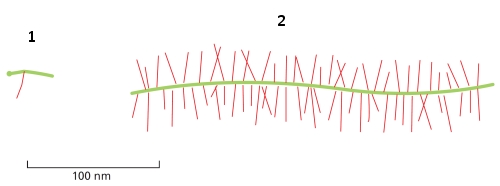
A) 1; 1
B) 1; 2
C) 2; 1
D) 2; 2

A) 1; 1
B) 1; 2
C) 2; 1
D) 2; 2

Unlock Deck
Unlock for access to all 56 flashcards in this deck.
Unlock Deck
k this deck
40
The size distribution of exons coding for collagen helical domains in various vertebrates reveals a unique pattern. This pattern provides clues to the evolutionary history of the genes encoding fibrillar collagen α chains. What is this pattern?
A) The length of most exons is a multiple of 100 nucleotides.
B) Most exons code for 54, or a multiple of 54, Gly-X-Y repeats.
C) The length of most exons is a multiple of 30 nucleotides.
D) Most exons code for 6, or a multiple of 6, Gly-X-Y repeats.
E) None of the above.
A) The length of most exons is a multiple of 100 nucleotides.
B) Most exons code for 54, or a multiple of 54, Gly-X-Y repeats.
C) The length of most exons is a multiple of 30 nucleotides.
D) Most exons code for 6, or a multiple of 6, Gly-X-Y repeats.
E) None of the above.

Unlock Deck
Unlock for access to all 56 flashcards in this deck.
Unlock Deck
k this deck
41
Platelets that express a constitutively active Rap1 are able to activate integrins even in the absence of thrombin stimulation. In contrast, cells expressing a binding-deficient version of talin are unable to perform integrin activation. In platelets expressing both of these mutant proteins, what would you expect to observe: the Rap1 gain-of-function phenotype (R) or the talin loss-of-function phenotype (T), as described above? Write down R or T as your answer.

Unlock Deck
Unlock for access to all 56 flashcards in this deck.
Unlock Deck
k this deck
42
A cell's response is not the same when placed on a rigid compared to a soft matrix. Indicate whether each of the following is expected to occur in a cell that is placed on a rigid matrix (R) or a soft matrix (S). Your answer would be a three-letter string composed of letters R and S only, e.g. RSR.
( ) More tension is generated in cell-matrix contacts.
( ) More vinculin proteins would bind to the C-terminal tail of talin.
( ) More actin filaments are recruited to the site of cell-matrix adhesion.
( ) More tension is generated in cell-matrix contacts.
( ) More vinculin proteins would bind to the C-terminal tail of talin.
( ) More actin filaments are recruited to the site of cell-matrix adhesion.

Unlock Deck
Unlock for access to all 56 flashcards in this deck.
Unlock Deck
k this deck
43
How does talin activate the inside-out signaling through integrin?
A) It binds to both integrin subunits to bring them together in an interlocked conformation.
B) It is a protein kinase that phosphorylates both integrin subunits and induces activation by conformational change.
C) It competes with the α subunit for binding to the β subunit, therefore blocking intimate α-β linkage.
D) It binds to the α subunit, and dissociates the dimer into individual subunits that are functionally active.
A) It binds to both integrin subunits to bring them together in an interlocked conformation.
B) It is a protein kinase that phosphorylates both integrin subunits and induces activation by conformational change.
C) It competes with the α subunit for binding to the β subunit, therefore blocking intimate α-β linkage.
D) It binds to the α subunit, and dissociates the dimer into individual subunits that are functionally active.

Unlock Deck
Unlock for access to all 56 flashcards in this deck.
Unlock Deck
k this deck
44
The following schematic drawing shows two integrin molecules. Which molecule (a or b) is depicted in its active configuration? Which side of the plasma membrane (1 or 2) represents the cytosol? 
A) a; 1
B) a; 2
C) b; 1
D) b; 2

A) a; 1
B) a; 2
C) b; 1
D) b; 2

Unlock Deck
Unlock for access to all 56 flashcards in this deck.
Unlock Deck
k this deck
45
EDTA is a metal-ion "chelator" that is commonly used to lower the concentration of free divalent cations in solution. In the lab, your friend has cultured a human cell line on elastic membranes that have been coated with fibronectin and attached to a device that can stretch the membrane. She has quantified the binding of talin to integrin under different conditions, and has presented the results in the following schematic graph, which shows the binding in the presence or absence of EDTA in the cell-culture medium. Which experiment (A or B) do you think was performed in the presence of EDTA? Write down A or B as your answer. 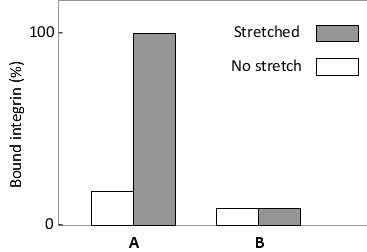


Unlock Deck
Unlock for access to all 56 flashcards in this deck.
Unlock Deck
k this deck
46
Which of the following molecules is capable of tension-sensing by exposing binding sites for other proteins when mechanically stretched?
A) α-Catenin
B) Talin
C) Fibronectin
D) All of the above
A) α-Catenin
B) Talin
C) Fibronectin
D) All of the above

Unlock Deck
Unlock for access to all 56 flashcards in this deck.
Unlock Deck
k this deck
47
Indicate whether each of the following descriptions better applies to the plant cell wall (W) or the extracellular matrix of animal cells (M). Your answer would be a three-letter string composed of letters W and M only, e.g. WMM.
( ) It is generally thicker and stronger.
( ) It is more rigid.
( ) It has higher nitrogen content.
( ) It is generally thicker and stronger.
( ) It is more rigid.
( ) It has higher nitrogen content.

Unlock Deck
Unlock for access to all 56 flashcards in this deck.
Unlock Deck
k this deck
48
A researcher has coated the wells in a multiwell plate with human plasma fibronectin. She introduces integrin-expressing cells into these wells in the presence of different concentrations of a synthetic peptide. She then washes the wells to remove unbound cells and counts the number of cells that remain attached to each well. The results of her experiment are presented in the following schematic graph. The synthetic peptide sequences used in these experiments were GRGDSPC (1) or GGDRSLN (2). Which one of these peptides (1 or 2) would you expect to correspond to curve a in the graph? Which curve (a or b) would you expect if a synthetic peptide with the sequence GDGRSPC was used? C is cysteine, D is aspartic acid, G is glycine, L is leucine, N is asparagine, P is proline, R is arginine, and S is serine. 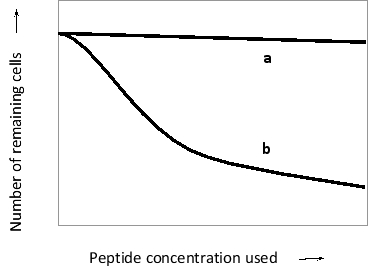
A) 1; a
B) 1; b
C) 2; a
D) 2; b

A) 1; a
B) 1; b
C) 2; a
D) 2; b

Unlock Deck
Unlock for access to all 56 flashcards in this deck.
Unlock Deck
k this deck
49
In the following schematic diagram of a cubic plant cell that has just left the meristem zone, the cellulose microfibrils are shown as black lines. In which direction (1 or 2) do you think the cell will elongate when the cell grows? If the cell wall is momentarily dissolved, in what direction (3 or 4) would water tend to flow? 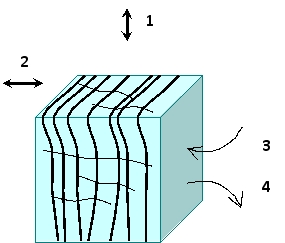
A) 1; 3
B) 1; 4
C) 2; 3
D) 2; 4

A) 1; 3
B) 1; 4
C) 2; 3
D) 2; 4

Unlock Deck
Unlock for access to all 56 flashcards in this deck.
Unlock Deck
k this deck
50
Indicate true (T) and false (F) statements below regarding integrin signaling. Your answer would be a four-letter string composed of letters T and F only, e.g. TFTT.
( ) Integrins usually bind their ligands with a higher affinity compared to other cell-surface receptors.
( ) Unlike cadherins, integrins usually function as individual dimers and do not cluster.
( ) Anchorage dependence is mainly mediated via integrin signaling.
( ) Integrins can activate the Ras-MAPK pathway.
( ) Integrins usually bind their ligands with a higher affinity compared to other cell-surface receptors.
( ) Unlike cadherins, integrins usually function as individual dimers and do not cluster.
( ) Anchorage dependence is mainly mediated via integrin signaling.
( ) Integrins can activate the Ras-MAPK pathway.

Unlock Deck
Unlock for access to all 56 flashcards in this deck.
Unlock Deck
k this deck
51
The focal adhesion kinase …
A) is a cytosolic serine/threonine kinase.
B) binds directly to integrin dimers.
C) can be phosphorylated by Src kinases.
D) prevents the relay of outside-in integrin signaling.
E) All of the above.
A) is a cytosolic serine/threonine kinase.
B) binds directly to integrin dimers.
C) can be phosphorylated by Src kinases.
D) prevents the relay of outside-in integrin signaling.
E) All of the above.

Unlock Deck
Unlock for access to all 56 flashcards in this deck.
Unlock Deck
k this deck
52
Cellulose is deposited onto the plant cell wall in highly ordered crystalline aggregates by the cellulose synthase complex embedded in the plasma membrane. Would you expect cell wall deposition to continue following treatment of plant cells with a drug that depolymerizes microtubules? Would you expect these cells to be able to switch the orientation of the microfibril pattern between successive lamellae?
A) Yes; yes
B) Yes; no
C) No; yes
D) No; no
A) Yes; yes
B) Yes; no
C) No; yes
D) No; no

Unlock Deck
Unlock for access to all 56 flashcards in this deck.
Unlock Deck
k this deck
53
In the active state of the integrin dimer, …
A) both intracellular and extracellular binding sites are exposed.
B) the intracellular binding sites are inaccessible, while the extracellular binding sites are exposed.
C) the intracellular binding sites are exposed, while the extracellular binding sites are inaccessible.
D) both intracellular and extracellular binding sites are inaccessible.
A) both intracellular and extracellular binding sites are exposed.
B) the intracellular binding sites are inaccessible, while the extracellular binding sites are exposed.
C) the intracellular binding sites are exposed, while the extracellular binding sites are inaccessible.
D) both intracellular and extracellular binding sites are inaccessible.

Unlock Deck
Unlock for access to all 56 flashcards in this deck.
Unlock Deck
k this deck
54
Indicate whether each of the following descriptions better applies to cellulose microfibrils (C) or pectins (P) in plant cell walls. Your answer would be a five-letter string composed of letters C and P only, e.g. CPPPP.
( ) It is made into a network by cross-linking glycans.
( ) It is particularly abundant in the middle lamella.
( ) Divalent ions such as calcium can cross-link it to form gels.
( ) It forms more homogeneous polymers.
( ) It contains many negatively charged galacturonic acid units.
( ) It is made into a network by cross-linking glycans.
( ) It is particularly abundant in the middle lamella.
( ) Divalent ions such as calcium can cross-link it to form gels.
( ) It forms more homogeneous polymers.
( ) It contains many negatively charged galacturonic acid units.

Unlock Deck
Unlock for access to all 56 flashcards in this deck.
Unlock Deck
k this deck
55
The chemical compound PMA is a potent stimulator of the epithelial-mesenchymal transition in epithelial cells. The activity of two of the following types of proteins is typically up-regulated in epithelial cells treated with PMA, while that of the other two is mainly down-regulated. Choose the two proteins whose activity you think is stimulated by PMA. Your answer would be a two-letter string composed of letters A to D only in alphabetical order, e.g. BC.
(A) Cadherin
(B) Connexin
(C) Matrix metalloprotease
(D) Integrin
(A) Cadherin
(B) Connexin
(C) Matrix metalloprotease
(D) Integrin

Unlock Deck
Unlock for access to all 56 flashcards in this deck.
Unlock Deck
k this deck
56
What is the most common additional polymer present in the plant secondary, but not primary, cell wall?
A) Cellulose
B) Pectin
C) Lignin
D) Starch
A) Cellulose
B) Pectin
C) Lignin
D) Starch

Unlock Deck
Unlock for access to all 56 flashcards in this deck.
Unlock Deck
k this deck



